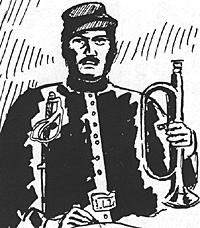 No historical gamer can deny the
popularity of the phenomenon of the card game called
Magic: The Gathering. It has spawned numerous
competitors and disrupted conventions from Delaware
to San Diego, and I will mention it no more in this
article.
No historical gamer can deny the
popularity of the phenomenon of the card game called
Magic: The Gathering. It has spawned numerous
competitors and disrupted conventions from Delaware
to San Diego, and I will mention it no more in this
article.
However, a recent and welcome arrival in this field is the game Dixie, produced by Columbia Games, Inc. This "collectable tradable card game" is designed to provide two opposing players the opportunity to fight Civil War battles.
The first release in this range is, appropriately, First Bull Run (or First Manassas, if you are of a Rebel persuasion). Further releases are planned, with Shiloh in pre-production and Gettysburg promised someday.
The cards come in boxes of 60, with an equal assortment of Union and Rebel cards in each box. There are 200 cards available in this first series, 100 for each side. This means you can theoretically start playing with a single box, though I recommend getting at least two.
The cards themselves are on good quality stock and will last if you treat them properly. The artwork is amateurish compared to other card games on the market, but the pictures are still colorful and appealing (except for the deplorable use of the same picture for all the terrain cards in the game).
Unlike most of the trading card games out, there is no deliberate varying of rarity among the cards (in other words, there are plenty of Stonewall Jackson cards to go around). Five or six boxes and some judicious trading should provide you a complete set. This process is made even easier, since you are only allowed to use one of each card in a game (there is only one Stonewall Jackson, and only one First US Dragoons, after all).
There are six categories of cards: Commanders, Infantry, Cavalry, 'Artillery, Terrain and Specials. The Commander cards represent all the major commanders at the battle; they are used to keep troop morale high. The Infantry, Artillery and Cavalry cards represent regiments and batteries which were there; these have different values for fire combat, morale and melee (do I really need to explain this to historical gamers?). Terrain cards modify the values of troops, and Specials provide some useful (and occasionally hilarious if you aren't the target of them) one-time situation modifiers.
Each player/side sets up card stacks to represent his own left flank, center, and right flank. Then he must decide if he will advance against the opposing positions in an assault, lob artillery fire at those positions, or just hold a position against anticipated enemy attack. Creeks restrict movement towards the enemy; woods provide cover for defenders; railroads can rush reinforcements for a sudden attack. A general may try to outflank the enemy (of course, his troops may get confused, misunderstand their orders and just stand around for a while).
The rules are badly written, but the concepts behind them are clear. Play till you figure them out, because this game is worth it. At 30-60 minutes for a game, you will be seeing this game at lots of conventions.
Back to Table of Contents The Messenger February 1995
Back to The Messenger List of Issues
Back to MagWeb Magazine List
© Copyright 1995 by HMGS/PSW.
This article appears in MagWeb.com (Magazine Web) on the Internet World Wide Web.
Other articles from military history and related magazines are available at http://www.magweb.com